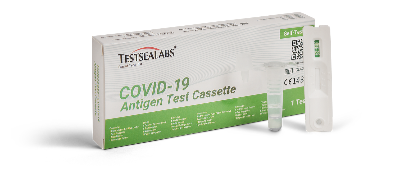More than 98% Omicron sensitivity confirmed in the laboratory
- Testsealabs.de

- Oct 8, 2022
- 3 min read
To give users of the Testsealabs® Antigen Rapid Test maximum confidence, we regularly validate the test with new SARS-CoV-2 virus variants. This is done together with our German laboratory partner, Biomex GmbH in Heidelberg.
In the meantime, the reliable detection of the Delta and Omikron variants could be confirmed in three validation studies. A total of 63 samples of the Omikron subvariants BA.1, BA.2, BA.4 and BA.5 were tested. The newest subvariants BA.4 and BA.5 were of great interest, as they strongly determine the infection events of the last months and have the potential to circumvent the previous immunity [1].
In the studies, the result of the Testsealabs® antigen rapid test was compared with the result of a PCR test. It was ensured that samples with low viral load (high ct value) as well as high viral load (low ct value) were tested. The ct values of the Omikron samples ranged from 23 to 37. The Testsealabs® Antigen Rapid Test was able to detect 62 of 63 Omikron samples, corresponding to a sensitivity of 98.4% (95% CI, 91.54 - 99.72%). Only one Omikron BA.1 sample with a low viral load could not be detected as positive. The studies confirm that the Testsealabs® Antigen Rapid Test is also suitable for the reliable detection of the latest Omikron BA.4 and BA.5 subvariants. Thus, the detection is not affected by the mutations of the newest SARS-CoV-2 variants. This confirms the results of the bioinformatic analysis and the examination of the test antibodies in the laboratory.


Testsealabs Rapid Antigen Test 25 tests - professinal users
delivery in 1-2 working days

Testsealabs Antigen Schnelltest 1 test - lay users
delivery in 1-2 working days
Why can the testsealabs antigen test detect new variants?
Although the Testsealabs® Antigen Rapid Test has been on the market for almost two years, it can still reliably detect COVID-19 infection. At the same time, however, new mutant viral variants continue to evolve that bypass previous immunity and evade detection by the immune system. How can this be? Is this not a contradiction?
No, for that it is necessary to understand how recognition by antigen rapid tests differs from the immune system. Recognition and combat by the immune system is based in large part on the spike (S) protein on the surface of the virus. This allows the recognition and neutralization of intact virus particles before they enter the cell. The spike protein is also presented to the immune system by most vaccines, so there is strong evolutionary pressure to prevent recognition by new mutations. Thus, new SARS-CoV-2 variants differ mainly by a large number of mutations in the S protein. This is also the case with the latest Omikron subvariants BA.4 and BA.5 [2].
The Testsealabs® Antigen Rapid Test uses the nucleocapsid (N) protein for detection, which is located inside the virus particle and interacts differently with the immune system. Development in recent years has shown that it mutates more slowly. Thus, it can still be detected by the Testsealabs® Antigen Rapid Test.
Why does the detection of new virus variants need to be verified in the laboratory?
Although the Testsealabs® Antigen Rapid Test detects a very constant component of the virus, any new mutation has the potential to affect this. Omikron subvariant BA.4 is of particular interest as it carries a mutation in the nucleocapsid protein where the amino acid proline at position 151 has been replaced by a serine. This mutation is located in the part of the protein that is recognized by the test antibodies and could therefore impair recognition.
Since COVID-19 is a dangerous, and in severe cases life-threatening, disease, it is important to provide all users with a safe and efficient test. Therefore, each variant is validated by the manufacturer of the test and the test antibodies in several steps. This starts with a bioinformatic analysis, followed by laboratory testing with the antibody and finally validation studies with real patients.
You still have questions? Feel free to contact us!
+49 451 30 50 29 91
[1] Khan, K., Karim, F., Ganga, Y. et al. Omicron BA.4/BA.5 escape neutralizing immunity elicited by BA.1 infection. Nat Commun 13, 4686 (2022). https://doi.org/10.1038/s41467-022-32396-9
[2] Tegally H, Moir M, Everatt J, et al. Continued emergence and evolution of Omicron in South Africa: new BA.4 and BA.5 lineages. medRxiv. 2022. doi:10.1101/2022.05.01.22274406


Comments